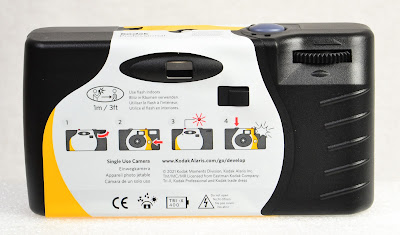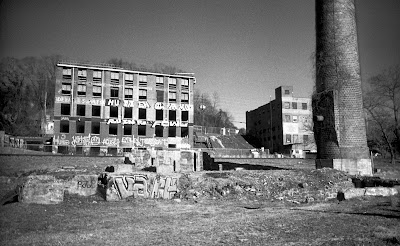Last year, Kodak introduced their single-use camera loaded with a roll of Tri-X film. I was initially skeptical, but finally ordered one from the Film Photography Project Store. Seeing that I have been working on an issue of Monochrome Mania dedicated to 35mm toy cameras, I really had to try out this camera (the issue will be available in late March from my Etsy shop). For starters, the phrase "Kodak Professional" on the front of this little plastic camera seems laughable, but just go with it. The camera is pre-loaded with a 27 exposure roll of Tri-X, which is a 400 ISO black and white film. There is a built-in flash, so other than the film, the camera is similar to Kodak's Fun Saver series of cameras. I mostly shot outdoors, and only used the flash as a fill-flash and not as the sole light source, so I did not evaluate the performance in a dark indoor setting. I suppose like any of these cameras, the small flash will be good for up to 10 feet. The angle of view is wide, as the lens is a 30mm f/10, 2-element acrylic lens. The focus distance is 1 meter to infinity.
I shot with the camera over the course of over a month, and its compactness allows it to easily fit into a shirt pocket, as well as any space in a camera bag. I should note that I taped a yellow gel over the lens when shooting on sunny days, so that I would not overexpose the image, and to achieve better tonality. After I was finished with the roll, I opened the camera body and removed the film cassette, which other than the serrated top of the spool, looks like any other roll of Tri-X, and with the chrome cap ends.
I developed the film in the FPP D-96 developer for 8 minutes, and did the standard fix and wash that I do for all my black and white films. Overall, I have to say that I am pleased with the results. Tri-X fell out of favor with me because the film base always cupped when dried. That's a real pain in the ass when I am trying to load it into the Epson scanner film holders, and films that lie perfectly flat are my preference. Perhaps Kodak's made some changes, because this time, the film was almost perfectly flat. The other factor is that the cameras are assembled in China, and maybe the film is made there, as well. That could be a reason for the difference.
If you are new to film photography, and want to experience shooting B&W, this is a good way to try it out. I have seen prices in the $11-$14 range, so the camera is pretty cheap. On the other hand, Ilford has a single-use B&W camera loaded with Ilford HP5+. I've not tried the camera, but HP5+ is the film that I prefer over Kodak Tri-X. The price for the Ilford alternative is in the same price range. In addition, Harman sells a single-use camera loaded with Ilford XP-2, a C-41 film (that can also be developed in b&w chemistry). Lomography also sells a simple-use camera loaded with 400 ISO Lady Grey film. If you just want a simple camera loaded with B&W film, you could get a Harman 35 reloadable which comes with 2 rolls of Kentmere 400 for about $30.
 |
| The Harman camera w/2 rolls of Kentmere 400 is a good value. |
You CAN reload the Kodak camera with another roll of film, and if if you are careful opening the camera body, you'll quickly see how that would work. It would probably be best to use a 24-exposure roll as the counter starts at 27. I'll give it a try later on and see if it works with a normal cassette, or if I have to use the one with a serrated end to the film spool (like the one that was in the camera). The wider view of the Kodak camera certainly is a plus, and I felt that the lens was plenty sharp enough.
Of course, if you don't develop film yourself, The Darkroom Lab can develop it and you can get scans and prints from that roll of Tri-X.
Here are some examples from the roll of Tri-X, and I am quite happy with them.















1 comment:
Nice frames. Some Chinese vendors have remounted the Kodak 30mm ƒ/10 lens in plastic mounts for Leica 39mm thread and Leica M. I tried one of the LTM ones on my Leica IIIC. It's OK, but mine may be misaligned. Still, it's an interesting inexpensive option. Now I "need" that 28mm ƒ/5.6 Summaron.....
Post a Comment